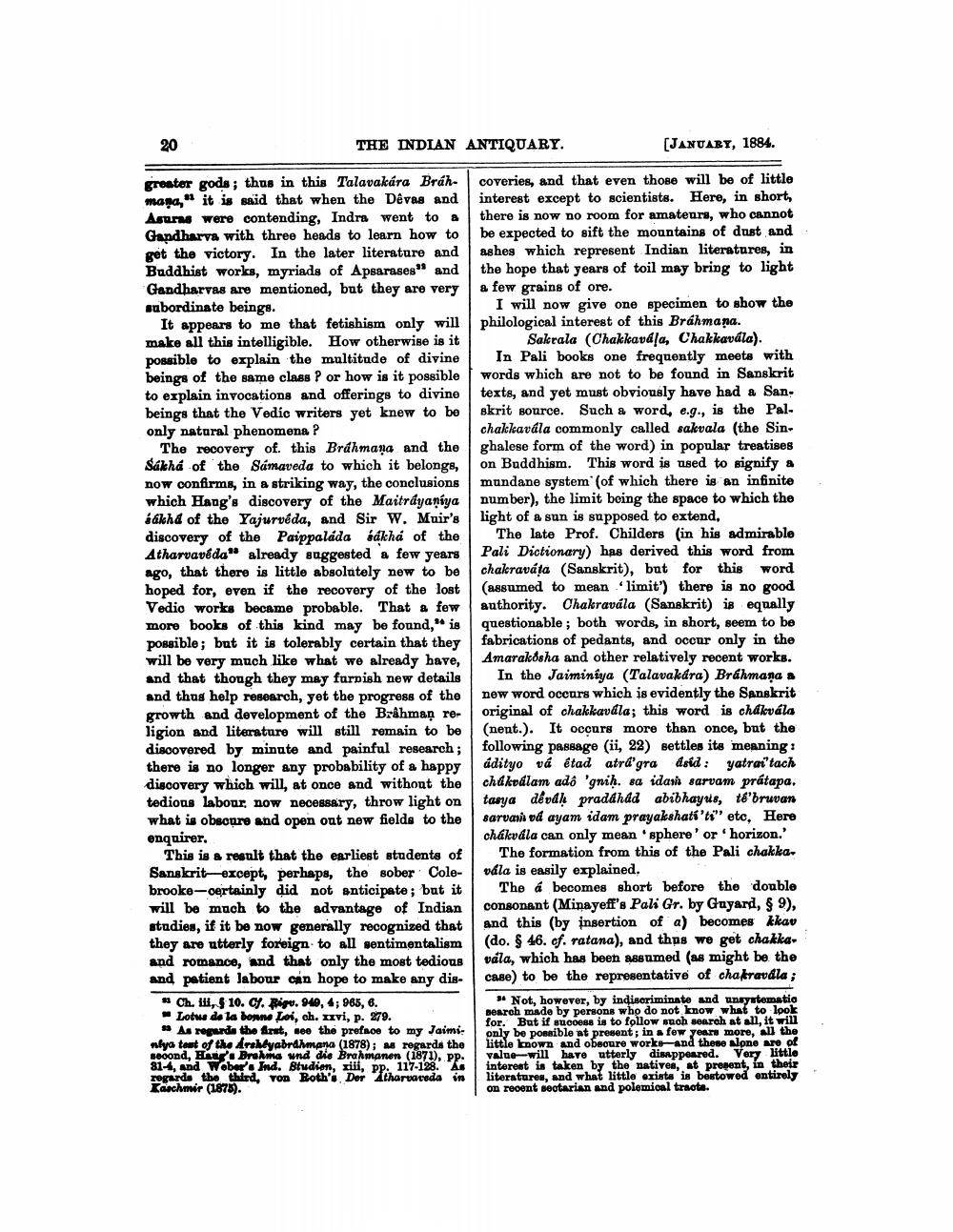________________
20
THE INDIAN ANTIQUARY.
[JANUARY, 1884.
greater gods; thus in this Talavakára Bráh- coveries, and that even those will be of little mana," it is said that when the Devas and interest except to scientists. Here, in short Asurns were contending, Indra went to a there is now no room for amateurs, who cannot Gandharva with three heads to learn how to be expected to sift the mountains of dust and get the victory. In the later literature and ashes which represent Indian literatures, in Buddhist works, myriads of Apsarases" and the hope that years of toil may bring to light Gandharvas are mentioned, but they are very | a few grains of ore. subordinate beings.
I will now give one specimen to show the It appears to me that fetishism only will philological interest of this Brahmara. make all this intelligible. How otherwise is it
Sakrala (Chakkavála, Chakkavála). possible to explain the multitude of divine In Pali books one frequently meets with beings of the same class P or how is it possible words which are not to be found in Sanskrit to explain invocations and offerings to divine texts, and yet must obviously have had a San. beings that the Vedic writers yet knew to be skrit source. Such a word, e.g., is the Palonly natural phenomena ?
chakkavála commonly called sakvala (the Sin. The recovery of this Brahmana and the ghalese form of the word) in popular treatises Sakha of the Sámaveda to which it belonge, on Buddhism. This word is used to signify a now confirms, in a striking way, the conclusions mundane system (of which there is an infinite which Hang's discovery of the Maitrdyaniya number), the limit being the space to which the áálhd of the Yajurvéda, and Sir W. Muir's light of a sun is supposed to extend, discovery of the Paippalada óákhá of the The late Prof. Childers (in his admirable Atharvavada" already suggested a few years Pali Dictionary) has derived this word from ago, that there is little absolutely new to be chakraváta (Sanskrit), but for this word hoped for, even if the recovery of the lost (assumed to mean limit') there is no good Vedio works became probable. That few authority. Chakravala (Sanskrit) is equally more books of this kind may be found," is questionable ; both words, in short, seem to be possible; but it is tolerably certain that they fabrications of pedants, and occur only in the will be very much like what we already have, Amaraksha and other relatively recent works. and that though they may furnish new details
In the Jaiminiya (Talavakára) Brahmana a and thus help research, yet the progress of the new word occurs which is evidently the Sanskrit growth and development of the Brahman re- original of chakkavála; this word is chalovála ligion and literature will still remain to be (nent.). It occurs more than once, but the discovered by minute and painful research; following passage (ii, 22) settles its meaning : there is no longer any probability of a happy adityová étad atrá'gra dsid : yatrai'tach discovery which will, at once and without the chdkrdlam ado 'gnih, sa idaria sarvam prátapa. tedious labour, now necessary, throw light on tasya dêvdpradáhád abibhayris, t&'bruvan what is obscure and open out new fields to the saruani vd ayam idam prayakshati'ts" etc, Here enquirer.
chákvdla can only mean sphere' or horizon.' This is a result that the earliest students of The formation from this of the Pali chakka. Sanskrit except, perhaps, the sober Cole- vála is easily explained. brooke-oertainly did not enticipate ; but it The á becomes short before the double will be much to the advantage of Indian consonant (Minayeff's Pali Gr. by Gayard, $ 9), studies, if it be now generally recognized that
and this (by insertion of a) becomes kkav they are utterly foreign to all sentimentalism (do. $ 46. of. ratana), and thus we get chakka. and romance, and that only the most tedious vala, which has been assumed (as might be the and patient labour can hope to make any dis- case) to be the representative of chakravdia; # Ch. 11, 9 10. ch. Pigu. 940, 4; 965, 6.
* Not, however, by indiscriminate and unsystematio Lote de la bonne Loi, ch. xxvi, p. 279.
Benroh made by persons who do not know what to look
for. But if sucess is to follow such search at all, it will As regards the first, see the preface to my Jaimi.
only be possible at present; in a few years more, all the alya tent of the Arshtyabrdhmana (1878); M rogards the little known and obscure work and these alone are of sooond, Has Brahma und die Brahmanon (1871), pp. value will have utterly disappeared. Very little 81-4, And Weber'. Ind. Btudion, viii, pp. 117-128. As interest is taken by the natives, at pregent, in their regards the third, von Roth's Der Atharvavada in literatures, and what little erista is bestowed entirely Kaschmir (1875).
on recent sectarian and polemical tracta.




